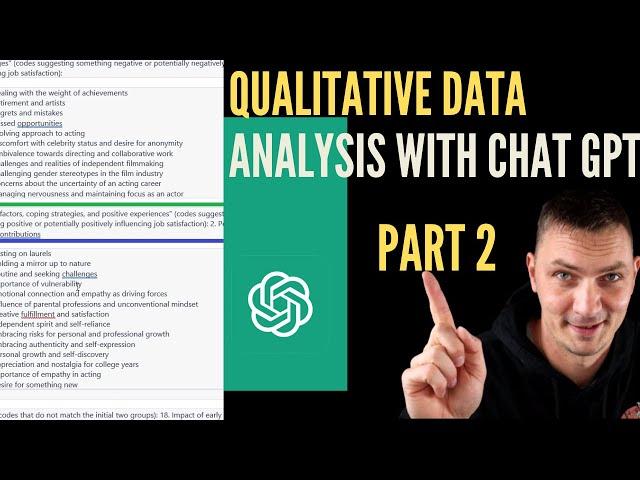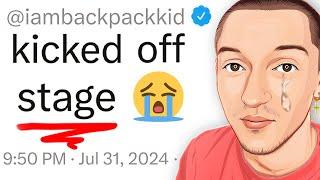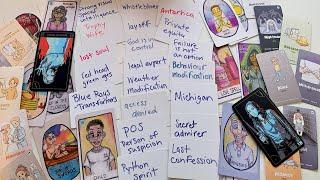
Thematic analysis with ChatGPT | PART 2- Coding qualitative data with ChatGPT
Комментарии:

Interesting! Thanks for posting part 2. I'm curious how chatgpt will analyse textual data which isn't that straightforward to code as it was in your research questions. I mean that "Positive, challenges, personal, external" are quite straightforward. I've tried to analyse my data with chatgpt to see whether it would match my coding decisions. Surprisingly, 80% of its codes were close to theory-driven codes, with some repetitions though.
Ответить
Thank you! :)
Ответить
Interesting use of chatgpt
Ответить
Thank you for posting! Sir also you promised Part 3 for today (Parts 2 and 3 of the video coming on Sunday)
Ответить
I used NVivo to code interviews for my thesis, and ChatGPT to compare the results. ChatGPT is so good at this, thanks to your prompts. Obviously, ChatGPT misses some things, but other things that I didn't code were correctly coded by it. Fantastic assisting tool. I ordered all my codes in NVivo yesterday and was wondering how to do it on ChatGPT, and your video came right on time! Thanks
Ответить
Thank you Dr. for this. Before watching your video, I tried the sorting of codes through ChatGPT and I had luck with this prompt:
You are a researcher. 7 interviews were conducted, and from each interview, codes were derived. A total of 125 codes were gathered. You need to group these codes into categories or themes of similar context. Use all the codes. Codes that fall into multiple themes, choose the best theme that it fits. Don't use codes more than once. Any codes that don't fit the categories or themes made, group them separately into 'ungrouped themes". Reference the interview and code number under each theme. Here are the codes:
Very minor mistakes but it was great start for sure.

Hi Sir, would like to see Prompt 6 for developing themes. Thank you!
Ответить
By “groups” do you means “categories” of the qualitative analysis?
Ответить
Please how do we end up with the themes, using ChatGpt?
Ответить
Thanks for this tutorial you're so amazing
Ответить
Thank you for the tutorial and for sharing your brilliant ideas. I was wondering if ChatGPT applied/detected similar codes across both interviews. After all, we are interested to see how many times the same code appears throughout the data.
Ответить
how many interviews would you do before bringing all your data together with the focussed codes
Ответить
Thank you sir, how themes will be derived after grouping codes. Kinsly upload part 3. I am eagerly waiting.
Ответить
What are the world's I normally I need to begin my discussion with got with to invite him to make the codes for me.
Ответить
voice could be louder. but thanks for the wonderful video.
Ответить
Have you tried asking chat gpt to do the thematic analysis for you entirely?
Ответить
So good! Are you willing to share the documents with the prompts? If you did, I missed them. Thank you!
Ответить
Which ChatGPT software are you using?
Ответить
I have to do coding of 20 transcription so it's helpful while doing other course work. The question I want to ask that If whole class use Chatgpt for coding then there codes would b same on same project so themes would be the same?
Ответить
Thankyou for the video! How to form themes from these groups/sub-groups? Is there any video you recommend me to watch to understand it better?
Ответить
Very interesting, thanks for sharing these videos!
I only have one question left. How should I start writing about the analysis? I'm not good at academic writing and I can't talk much about my researches, (tbh I feel it's unnecessary to talk so much about something I could tell you in half a page).

I will now paste "codes" (which are analytic units used in thematic analysis) here. I would like you to assign each of these codes to one of the following groups: "challenges" (if the code name suggests that it is something negative or something that may negatively influence a person's job satisfaction), "positive factors, coping strategies and positive experiences" (if the code name suggests that it is something in any way positive and may positively influence a person's job satisfaction), and "other" (for codes that do not match any of the initial two groups). Here are all codes, it is very important that you assign each and every one of these codes to the above-mentioned groups:
Ответить
Hi.
Instead of copying pasting each code (to separate from the quotes), I applied Heading 1 to the codes, made a table of contents, copied the table of contents an pasted onto a new sheet using the 'Keep text only' paste function so as to get rid of the hyperlinks.
I was dealing with quiet a number of codes, so pasting them all individually was going to drain me of my much needed umph. LOL
Thanks for the lesson.

God bless you good man
Ответить
Thank you so much for sharing this idea on how to use GPT. I think you really want to share the core thinking model for using AI-based tool for analysis, instead of the really simple way for only introducing how to do with the analysis.
I love the way and steps to more a clear and academic codes and themes.

Tq so much for your video. I’m wondering if I will need to cite ChatGPT in my methodology? Many thanks.
Ответить
Fantastic
Ответить
Thank you so much. This was very helpful and now with the new updates in chatgpt, it is even better.
Ответить

























